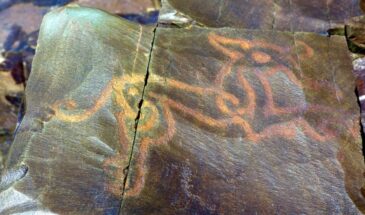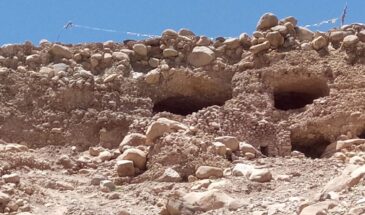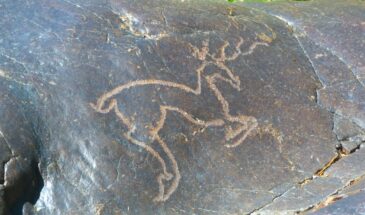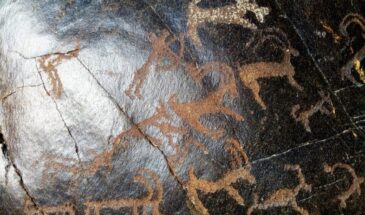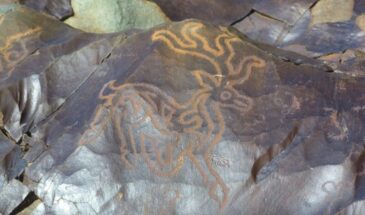- Overview
- Gallery
- FAQ
Ladakh Rock Art Tour
(Journey into the Prehistoric Soul of the Himalayas)
Overview
Ladakh’s timeless landscape is not only defined by its stark mountains and sacred monasteries but also by its ancient petroglyphs — rock engravings that offer a window into human existence thousands of years ago. Scattered along the banks of the Indus River and across hidden valleys, these prehistoric artworks depict animals, hunting scenes, rituals, and spiritual symbols, chronicling the life and beliefs of early Himalayan societies.
This tour is designed for travelers interested in archaeology, anthropology, history, and cultural landscapes. It also weaves in Ladakh’s rich natural beauty and spiritual heritage.
Best Season
May to September (clear weather, riverbanks accessible, mountain passes open)
Important Travel Requirements
-
Inner Line Permits: Required for Nyoma, Hanle, and Chumur sectors (available online or via travel agents in Leh).
-
Vehicle: 4x4 preferred; the terrain beyond Upshi is rugged and remote.
-
Guidance: A knowledgeable guide familiar with Ladakh's archaeology is highly recommended.
-
Conservation: No touching, scratching, or tampering with the petroglyphs. Photography without flash is advised.
Major Rock Art Regions and Sites
1. Domkhar Rock Art Sanctuary (Lower Indus Valley)
-
Located about 130 km west of Leh, Domkhar boasts one of Ladakh’s only dedicated rock art sanctuaries.
-
Over 300 petroglyph panels featuring images of ibex, yaks, humans, hunting scenes, solar symbols, and more.
-
Some carvings here date back to the Bronze Age, while others belong to later Buddhist periods.
-
The sanctuary is curated with signboards and walkways for easy exploration.
2. Khalatse and Wanla Belt (Lower Indus Valley)
-
Along the Indus River between Khalatse and Wanla, numerous petroglyph sites are found on rocks near riverbanks and fields.
-
Key motifs include animals, archaic chariots, stylized humans, and mysterious geometric figures.
-
Combines beautifully with a visit to Wanla Monastery, known for its ancient Avalokiteshvara temple.
3. Tangtse (Changthang Plateau)
-
Near the route to Pangong Lake, Tangtse’s petroglyph fields lie close to the old trade route to Tibet.
-
Displays of wild goats, yaks, hunting scenes, and ritualistic engravings.
-
These artworks narrate the migratory and pastoral lifestyles of early Changthang inhabitants.
4. Upshi to Hemis Stretch (Upper Indus Valley)
-
Between Upshi and the famous Hemis Monastery, hidden near riverbeds and hillsides, smaller but significant petroglyph clusters are found.
-
Common motifs include ibex, blue sheep, mountain goats, and scenes depicting early pastoralism.
-
This stretch combines natural beauty with archaeological mystery, often overlooked by casual tourists.
5. Rong Valley, Nyoma Sector (Southeastern Ladakh)
-
In Rong Valley, along the riverbanks of Nyoma and its surroundings, large panels of petroglyphs have been documented.
-
The art includes hunting scenes, masked figures, ritual depictions, and prehistoric chariots.
-
Some carvings here suggest symbolic or spiritual purposes beyond mere storytelling.
6. Hanle and Chumur Region (Changthang)
-
In the remote far southeast, near Hanle village and onwards toward Chumur, extremely rare petroglyphs are found on isolated rocks and boulders.
-
These include chariots, wild sheep, human figures, spiral designs, and symbolic markings that hint at early ritual practices.
-
Combining this with a visit to the Hanle Dark Sky Reserve offers a powerful contrast — ancient art under one of the world’s darkest, clearest skies.
Expanded Rock Art Areas (Optional but Significant)
-
Tegar and Sumda Chun Areas (off the main Indus near Saspol)
-
Near Saspol, additional lesser-known but fascinating petroglyph sites exist.
-
Sumda Chun village itself is home to ancient heritage like the 11th-century Sumda Chun Monastery.
-
-
Saspol Caves (near Alchi)
-
Although primarily famous for Buddhist murals inside caves, some Saspol rock faces also exhibit transitional petroglyphic and painted elements from prehistoric to early Buddhist periods.
-
-
Bema–Skurbuchan Belt
-
Bema village near Skurbuchan in Sham Valley has scattered petroglyphs, mainly of ibex and mountain scenes.
-
Suggested Day-by-Day Itinerary (8 Days)
Day 1: Arrival at Leh
-
Acclimatization (rest day).
-
Visit Central Asian Museum and Ladakh Archaeological Museum for background on Ladakh's prehistoric cultures.
Day 2: Leh – Domkhar Rock Art Sanctuary – Khalatse – Wanla
-
Drive west along Indus.
-
Explore Domkhar Sanctuary.
-
Continue to Khalatse and Wanla areas for scattered petroglyphs.
-
Overnight at a guesthouse in Wanla or back to Leh.
Day 3: Leh – Upshi – Hemis
-
Drive southeast along Indus.
-
Explore hidden petroglyph spots between Upshi and Hemis.
-
Optional visit to Hemis Monastery.
-
Overnight in Hemis or return to Leh.
Day 4: Leh – Tangtse – Pangong Lake
-
Early drive to Tangtse.
-
Explore petroglyph sites before heading onward to Pangong Lake.
-
Overnight at Pangong or Tangtse homestay.
Day 5: Pangong – Nyoma via Chushul
-
Scenic drive via Chushul.
-
Petroglyph exploration along the way.
-
Reach Nyoma, visit Rong Valley sites.
-
Overnight in Nyoma.
Day 6: Nyoma – Hanle
-
Drive to Hanle.
-
Explore rare petroglyph fields en route.
-
Evening at Hanle Dark Sky Reserve.
-
Stargazing under one of Earth's clearest skies.
Day 7: Hanle – Chumur (Optional Extension) – Hanle
-
Excursion to Chumur (permit permitting).
-
Visit remote petroglyph sites.
-
Return to Hanle for overnight stay.
Day 8: Hanle – Leh
-
Long drive back to Leh.
-
Evening free for local handicrafts, souvenirs, or a quiet cultural walk.
-
This tour is moderately strenuous because of high altitude and long drives.
-
Fuel, food, and water should be planned carefully once beyond Upshi.
-
Camping options exist near Pangong, Hanle, and Nyoma for a more immersive experience.
-
Combining the rock art journey with Ladakh's monasteries, ancient trade routes, and natural wonders like Pangong Tso, Tso Moriri, or the Hanle observatories can create a once-in-a-lifetime experience.
No Details Found

